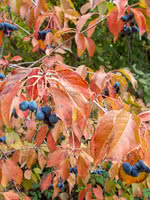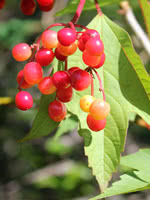Mon-Fri 9am - 5pm Mountain time
Highbush Cranberry vs Nannyberry
Viburnum lentago
Viburnum opulus var. americanum (trilobum)
NOT AVAILABLE THIS SEASON - MIGHT RETURN
Nannyberry is a hardy shrub known for attracting wildlife. Its clusters of white flowers and tasty berries are suitable for bees, birds, and other animals.
Nannyberry is also used in urban yards and landscaping. This shrub makes a beautiful ornamental and is small enough to grow underneath power lines. Its berries can be eaten fresh or used in baking and preserves.
Makes a great hedge or privacy screen in an urban yard. Often has great red fall color to complement its spring flowers.
Highbush Cranberry produces attractive white flowers in late June and bears edible fruit that matures to a bright red colour in the late summer.
This shrub, native to much of Canada, is fast growing, and its fruit can be eaten raw or cooked into a sauce.
Nannyberry Quick Facts
Highbush Cranberry Quick Facts
In row spacing: 0.6 m (2.0 ft)

